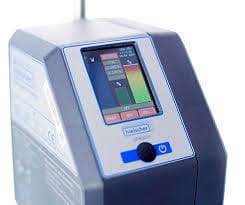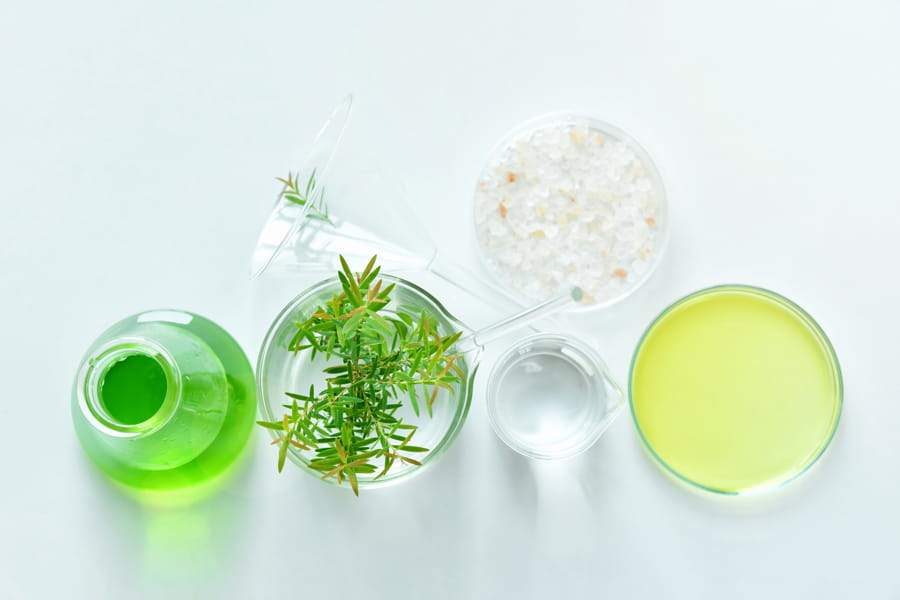
Botanical products, such as leaves, petals, flowers, stems, roots and bark, contain potent bioactive compounds (phytochemicals) that are used in foods and beverages, dietary supplements, therapeutic and pharmaceutical products, as well as cosmetic products.
Outstanding examples of botanical extracts are antioxidants, vitamins (e.g., vitamin A, C, E, K; B vitamins), proteins (e.g., hemp, soy), polyphenols, flavonoids, terpenes, cannabinoids (e.g., CBD, CBG, THC), oligosaccharides and lipids (e.g., omega-3 from flax or hemp seeds).
Antioxidants act as a powerful defense mechanism that prevents the body’s cells from damage caused by aging, stress, inflammation and disease.
Research also shows that antioxidants can help improve the immune system and have anti-cancer properties.
In addition, antioxidants prevent oxidation of the products and thus prolong their stability and shelf life.
Therefore, antioxidants are added to many foods and beverages, nutritional supplements, therapeutic products and cosmetics.
Very prominent examples of antioxidants are vitamin E (α-tocopherol), vitamin C (ascorbic acid), beta-carotene and glutathione.
Antioxidants and other bioactive compounds can be extracted from natural materials, such as botanicals or algae, or artificially synthesized.
Bioactive compounds extracted from a natural source have greater bioavailability and bioaccessibility and, therefore, greater potency.
Therefore, naturally extracted phytochemicals are used in high-quality supplements.
To obtain high quality botanical extracts, not only the raw material (plant material) is essential, but also the extraction technique applied is crucial.
Plant extracts are temperature sensitive, which means that they degrade with heat.
Therefore, it is crucial to choose a non-thermal extraction method.

The selection of the extraction solvent is another important factor, which influences the quality of the extract.
Solvents such as hexane, methanol, butane and other aggressive chemicals can contaminate the extract.
Although solvents are removed after extraction, traces of toxic solvents may be found in the final extract.
Water, alcohol, ethanol, glycerin or vegetable oils are safe, non-toxic and FDA approved solvents for consumption.
Ultrasonic extraction is based on the working principle of ultrasonic/acoustic cavitation and is a purely mechanical treatment.
Like a high shear mixer, an ultrasonic only creates mechanical shear forces in the process medium.
Ultrasonic extraction is a non-thermal, chemical-free extraction technique.
Acoustic or ultrasonic cavitation occurs when high-power, low-frequency ultrasound waves are coupled to a slurry composed of botanical material in a liquid (solvent).
High-power ultrasonic waves are coupled through a probe-type ultrasonic processor into the botanical sludge.
High-energy ultrasonic waves travel through the liquid creating alternating cycles of high and low pressure, resulting in the phenomenon of acoustic cavitation.
La cavitación acústica o ultrasónica conduce localmente a condiciones extremas, como diferenciales de presión muy elevados y altas fuerzas de cizallamiento.
Cuando las cavitation bubbles implode on the surface of solids (such as particles, plant cells, tissues, etc.), microjets and inter-particle collision generate effects such as particle breakage, sonoporation (the perforation of cell walls and membranes) and cell disruption.
In addition, the implosion of cavitation bubbles in liquid media creates turbulence and agitation, which promotes mass transfer between the interior of the cell and the surrounding solvent.
Ultrasonicirradiation is a very effective way to enhance mass transfer processes, as sonication leads to cavitation and its related mechanisms, such as micro motion by liquid jets, compression and decompression in the material with consequent disruption of cell walls.
Depending on the raw material, the ultrasonic extraction process may require high intensities, for example, to break up rigid plant cells or material with a large amount of cellulose.
Probe-type ultrasound can generate very high amplitudes, which is necessary to generate striking cavitation.
Hielscher Ultrasonic manufactures high-performance ultrasonic extractors, which can easily create amplitudes of 200µm in continuous 24/7 operation.
For even higher amplitudes, Hielscher offers specific large amplitude sonotrodes (probes).
Pressurizable ultrasonic reactors and flow cells are used to intensify cavitation.
As pressures increase, cavitation and cavitational shear forces become more destructive and thus enhance the ultrasonic extraction effects.

Ultrasonic extraction is used to release and isolate a wide variety of bioactive compounds (so-called phytochemicals) from botanicals.
The following list provides a brief summary of phytochemicals extracted by ultrasound:
Ultrasonic extraction is compatible with almost any solvent.
The most common are ethanol, water, ethanol/water mixture, glycerin and vegetable oils for the extraction of bioactive compounds from botanicals, as these solvents are considered safe for consumption and are easy to use.

Ethanolis one of the most widely used solvents in ultrasonic extraction due to its safety (FDA approved for consumption), its efficiency and its wide solvency.
Ultrasonic ethanol extraction outperforms other solvents and other extraction technologies in terms of cost-effectiveness, linear scalability, simplicity and safety.
The superior efficiency of ethanol as a solvent is linked to its chemical composition of a hydrocarbon tail and a single hydroxyl group.
This chemical composition allows ethanol to dissolve and extract a very broad spectrum of substances, from polyphenols, flavonoids, terpenes, cannabinoids and lipids (oils).
For example, ultrasound extraction of cannabinoids with ethanol does not require winterization (dewaxing), a necessary step with other extraction methods, such as CO2 extraction, to remove waxes.
Ethanol extraction has different effects depending on the ethanol temperature.
Heated ethanol is often used to produce full spectrum extracts, which are valued for their enveloping effect.
On the other hand, ice-cold ethanol is preferably used to produce herbal or cannabis distillates.
Extraction in ice-cold ethanol does not require subsequent filtration.
Since ultrasonic extraction is a non-thermal treatment, it can be used with hot/tempered or refrigerated/cold ethanol.
The jacketed ultrasonic reactors help to maintain the desired processing temperature during treatment.
The digital control and intelligent ultrasound software monitors the processing temperature via plug-in temperature sensors and can be programmed to stop or pause the extraction treatment when the temperature of the medium exceeds a certain range.
Los sistemas de extracción de alto rendimiento de Hielscher Ultrasonics están disponibles a cualquier escala, desde el pequeño tamaño de laboratorio, la escala piloto de tamaño medio hasta la producción totalmente industrial de varias toneladas por hora.
Depending on the throughput, Hielscher ultrasonic extractors can be used in batch or continuous in-line mode.
The choice of solvent is up to you, as Hielscher ultrasonics can be used in combination with any solvent.
All ultrasonic extraction devices are simple and safe to operate.
Depending on your raw material, process capability and throughput target, Hielscher offers you the most suitable ultrasound.
Los procesos de extracción por ultrasonidos están influenciados por la materia prima, el disolvente y el rendimiento.
Various accessories are available, such as sonotrodes (probes) of different sizes and shapes, booster horns, flow cells with different volumes and geometries, plug-in temperature and pressure sensors and many other gadgets to assemble the ideal ultrasonic configuration for your extraction process.
Process control is crucial to obtain reproducible results.
Therefore, all digital models are equipped with intelligent software that allows the extraction parameters to be adjusted, monitored and reviewed.
Thanks to precise control of amplitude, sonication time and duty cycles, optimum process results can be achieved, such as superior yield and maximum extract quality.
Automatic recording of sonication process data is the basis for process standardization and reproducibility/repeatability, which are required for good manufacturing practices (GMP).

TÖUFOOD is a complete line of products of exceptional quality, developed by GASTROCULTURA MEDITERRÁNEA SL, which allows the most well-known techniques of modern cuisine to be put into practice. Innovative recipes can be easily realised, bringing excitement and surprise to dishes, offering a stimulating and memorable culinary experience.